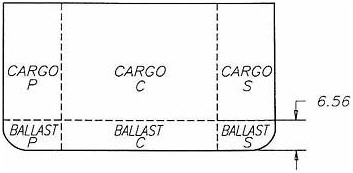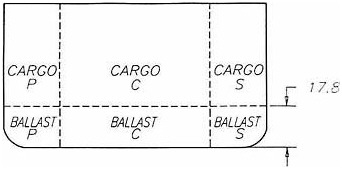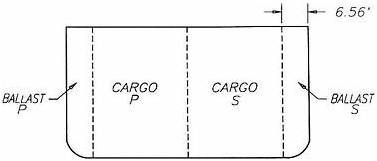APPENDIX D
35,000 DWT Tanker Cargo Capacity and Damage Stability Study
Seaworthy Systems
November 1990
35,000 DWT TANKER CARGO CAPACITY AND DAMAGE STABILITY
A generic 35,000 DWT tanker was developed to investigate the effects of various segregated ballast tank (SBT) arrangements on the vessel's cargo carrying capacity and damaged stability characteristics. The arrangements were provided with sufficient ballast capacity to meet the draft and trim requirements for tankage was divided into 10 transverse compartments. Eight arrangements were investigated. A midship section of the single skin design is illustrated in Figure D-1. Double bottoms of 2m (B/15) and B/5 in depth are presented in Figures D-2 and D-3. Double sides of 2m and B/5 in width are presented in Figures D-4 and D-5. Double hulls of 2m and B/5 in depth are presented in Figures D-6 and D-7. Centerline bulkheads were added to the 2m double side and double hull arrangements for damage survival considerations. Principal dimensions of the generic design are as follows:

NOTE: Most parametric studies of alternate tanker designs deal with VLCC-size tankers. Yet, much of the tanker traffic of interest to the United States is and will continue to consist of smaller tankers. Accordingly, Seaworthy Systems, Inc., was requested to examine alternate designs for a ''handy-sized" tanker of 35,000 DWT. The study is attached. It is emphasized that the various designs were not optimized. Nonetheless, they are valid to demonstrate that double hull tankers in the lower size range can be designed with damage resistance far in excess of present requirements.
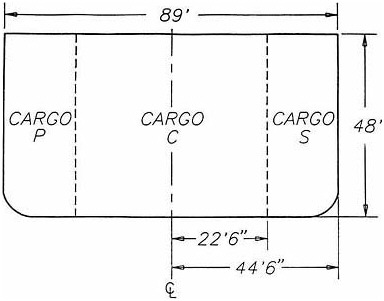
FIGURE D-1 Typical midbody 35,000 DWT tanker.
Protectively Located Ballast Requirements
The SBT arrangement must meet capacity and location requirements of 33 CFR 157.10. The ballast capacity must be sufficient to allow the vessel to meet ballast draft and maximum trim requirements. The ballast must be arranged in wing or double bottom tanks to minimize cargo outflow in the event of damage to the hull. Also, the ballast arrangement must not result in a stress numeral of over 100. (Stress numerals were not investigated in this study.)
The ballast capacity and arrangement must keep the propeller 100 percent immersed. Trim in the ballast condition must not exceed 1.5 percent of the vessel's length. The draft amidships must be at least 2 meters plus 2 percent of the vessel's length.
The projected area of PL/SBT tankage must exceed the amount required by an equation which is based upon the vessel's L, B, D and deadweight. For wing tanks to be considered effective they must be at least 2 meters wide. The minimum depth of the double bottom is B/15 or 2 meters, whichever is less. In this study we used 2 meter sides as required and 2 meter double bottoms in order to allow for tank inspection.
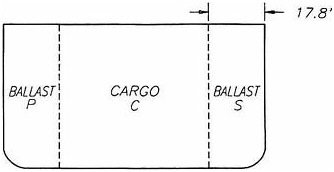
FIGURE D-5 35,000 DWT tanker with B/5 double side.
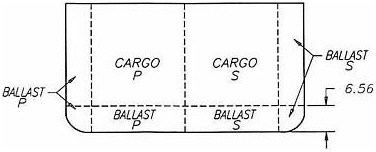
FIGURE D-6 35,000 DWT tanker with 2 meter (B/15) double hull.
Draft, trim, and ballast distribution were calculated for the eight arrangements. The arrangements with double sides, bottom and hull exceed the area requirements. The 2 meter double bottom, sides and hull arrangements require additional ballast capacity to meet the draft and trim requirements. The ballast arrangements for the various configurations are provided in Figures D-2 through D-7.
Cargo Capacity
Table D-1 compares the cargo carrying capacities of the various SBT configurations. All of the SBT tank arrangements result in vessels which are volume rather than deadweight limited. The single skin design loses 29
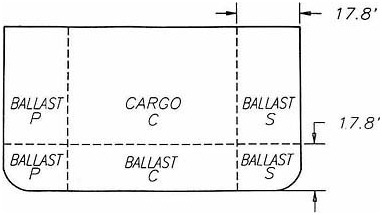
FIGURE D-7 35,000 DWT tanker with B/5 double hull.
percent of its volume to segregated ballast. The 2 meter double bottom loses 26 percent. The 2 meter double sides loses 27 percent. The 2 meter double hull loses 28 percent. The double skin arrangements lose less due to the effective use of wing and bottom tankage. The B/5 double bottom and sides lose 10 percent more cargo. The single skin design would lose a bit less if the bulkhead arrangements were optimized for the ballast tankage. The double hull, bottom or side arrangements meet MARPOL draft and trim requirements but were not optimized; therefore, internal tanks had to be used for ballast.
Damage Stability
The damage stability analysis was performed with the vessels fully loaded with cargo at a density of 6.63 BBL/LT (Bunker C). The loaded cargo tanks were assumed to be five percent permeable to account for the density of the cargo and the amount of cargo carried in the tank. The segregated ballast tanks were assumed to be 99 percent permeable which corresponds to an empty tank. Cases investigated include 1, 2, and 4 compartment damage.
For vessels to meet damage stability requirements, they must comply with the following. The equilibrium heel due to unsymmetrical flooding must not exceed 25 degrees. The vessel's righting lever curve must have a range of 20 degrees beyond the equilibrium heel angle. The maximum
righting arm must be at least 4 inches (0.1 meter). All the configurations were able to meet these requirements for 1 and 2 compartment damage.
The worst case scenario for 4 compartment damage stability is presented in Table D-2. This table illustrates the results of the analysis. The single skin hull has the least equilibrium heel angle. The 2m (B/15) double hull provides the greatest maximum righting arm. The greatest range of stability is 70 degrees. The following four configurations meet this range; PL/SBT single skin, 2m double bottom, 2m double sides, 2m double hull. The B/5 double side and double hull have excessive heel and a reduced range of stability. The B/5 double bottom arrangement results in the worst damage stability characteristics. The maximum righting arm is only 0.4 feet which meets the requirement, but its range of positive stability is only 17°, which does not meet the requirements.
Conclusions
The use of SBT result in designs that are volume-(cubic) rather than deadweight-limited. Although further optimization of tank arrangements may result in less volume loss in a single skin design than is shown in this analysis, the double bottom, side or hull arrangement can also be optimized to result in similar cargo capacities. The study also indicates that the double skin can be taken too far resulting in excessive loss of cargo carrying capacity and degradation of damage stability characteristics.
TABLE D-1 35,000 DWT Tanker—Loss of Cargo Carrying Capacity
|
35,000 DWT TANKER - LOSS OF CARGO CARRYING CAPACITY |
||||||
|
ALTERNATIVE |
CARGO VOLUME AVAILABLE (FT3) |
CARGO DEADWEIGHT |
DEAD-WEIGHT OR VOLUME LIMITED |
% VOLUME AVAILABLE FOR CARGO |
||
|
1) BUNKER C 6.63 BBL/LT |
2) DIESEL OIL 7.38 BBL/LT |
3) GASOLINE 8.70 BBL/LT |
||||
|
SINGLE SKIN (NO PL/SBT) |
1,730,000 |
35,580 |
35,580 |
33,673 |
1) DWT; 2) DWT; 3) VOLUME |
100% |
|
SINGLE SKIN+ W/ PL/SBT |
1,232,684 |
31,485 |
28,285 |
23,994 |
1) VOLUME; 2) VOLUME; 3) VOLUME |
71 % |
|
2M DOUBLE BOTTOM+ |
1,272,198 |
32,494 |
29,191 |
24,763 |
1) DWT; 2) VOLUME; 3) VOLUME |
74 % |
|
2M DOUBLE SIDES+ |
1,264,197 |
32,290 |
29,008 |
24,607 |
1) DWT; 2) VOLUME; 3) VOLUME |
73 % |
|
2M DOUBLE HULL+ |
1,239,397 |
31,656 |
28,439 |
24,124 |
1) VOLUME; 2) VOLUME; 3) VOLUME |
72 % |
|
B/5 DOUBLE BOTTOM |
1,098,883 |
28,067 |
25,215 |
21,389 |
1) VOLUME; 2) VOLUME; 3) VOLUME |
64 % |
|
B/5 DOUBLE SIDES |
1,083,955 |
27,686 |
24,872 |
21,099 |
1) VOLUME; 2) VOLUME; 3) VOLUME |
63 % |
|
B/5 DOUBLE HULL |
672,407 |
17,174 |
15,429 |
13,088 |
1) VOLUME; 2) VOLUME; 3) VOLUME |
39 % |
|
+ These designs were not optimized to maximize cargo capacity |
||||||
TABLE D-2 35,000 DWT Tanker—Four Compartment Damaged Stability, Worst Case Scenario
|
35,000 DWT TANKER |
||||
|
4 COMPARTMENT DAMAGED STABILITY WORST CASE SCENARIO |
||||
|
ALTERNATIVE |
DAMAGED SCENARIO |
EQUILIBRIUM HEEL (DEGREES) |
MAXIMUM RIGHTING ARM (FEET) |
RANGE OF STABILITY (DEGREES) |
|
SINGLE SKIN |
DAMAGE TO NO. 6,7,8 & 9; STBD CARGO TANKS |
1 |
4.34 |
70 |
|
B/15 (2M) DOUBLE BOTTOM |
DAMAGE TO NO. 5,6,7 & 8; STBD DOUBLE BOTTOM |
3 |
2.95 |
70 |
|
B/15 (2M) DOUBLE SIDE |
DAMAGE TO NO. 4,5,6 & 7; STBD WING TANKS |
6 |
3.26 |
70 |
|
B/15 (2M) DOUBLE HULL |
DAMAGE TO NO. 3,4,5 & 6; STBD WING TANKS |
7 |
9.50 |
70 |
|
B/5 DOUBLE BOTTOM |
DAMAGE TO NO. 3,4,5 & 6; STBD DOUBLE BOTTOM |
13 |
0.40 |
17 |
|
B/5 DOUBLE SIDE |
DAMAGE TO NO. 3,4,5 & 6; STBD WING TANKS |
16 |
3.05 |
50 |
|
B/5 DOUBLE HULL |
DAMAGE TO NO. 3,4,5 & 6; STBD WING TANKS |
12 |
5.2 |
50 |

